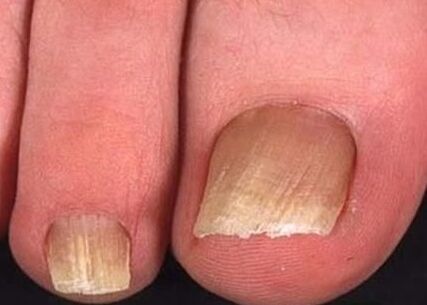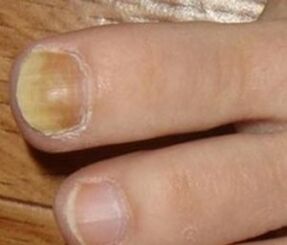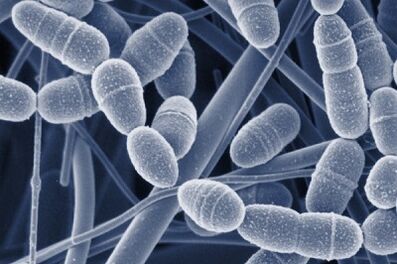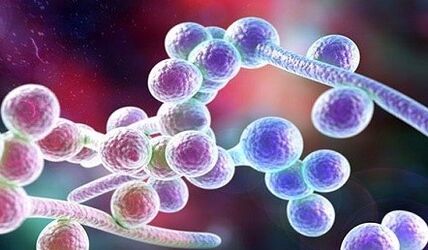
A healthy nail should have a nice appearance - to be smooth and even.Its color should be beige or slightly pink, which is due to the presence of blood vessels under it.When the defects appear, the nail can lose normal color, become dark or painted in different color.When the thickness changes, the nails become disordered and seem sloppy.In some diseases, the nails plates can be deformed to their disappearance.
Development malformations can be both congenital and acquired.In the first case, this is due to damage to the Actoder-Fabric-predecessor of the nail.It seems a deformation of the nail or its absence immediately after the birth of a child.
The acquired defects can develop for various reasons.The most common problem is a mushroom, which in one form or another is present in every third person.The mushroom can be not only external, in which only the plate is affected, but also by the internal ones: the fabric of the finger can be influenced by their subsequent destruction.
In addition, these diseases can lead to the deformation of the gradual step:
- Psoriasis - With this pathology, the thickness of the nail changes.It becomes more dense than usual and unpleasant to the touch.In addition, pain develops - on palpation, the discomfort is felt.Multilolor stains develop under the plate - from red to purple - this indicates an hemorrhage.When the infection is united, suppuration with hematomas can be observed under the nail.The local detachments from the skin can be observed - cavities are formed in these places that give their hands a disordered appearance.A further development of the disease can lead to onoricisi.
- Eczema is often accompanied not only by the local defeat, but also by generalized.That is, in addition to the damage to the plates, the symptoms of the skin can also be observed.The eczema occurs from changes in the nail roller and in the plate directly.The tissues of the finger become swollen, peeling can develop.The surface concerned itching and hurts.At the same time, the nail becomes boring and pale, its stratification or fragility is possible.
In addition to these reasons, the deformation can be caused by a fungal infection of the nail plate.
The mushroom is a disease that, with a negligent attitude, can lead to a complete destruction of the plate.In the initial phase, this is manifested only by a change of color and thickening, in the end, the defeat leads to the loss of the nail plate.
Signs of infection with a mushroom

When onychomicosis infection, there is no intense pain and disability, so people often prefer not to notice it.In addition, the mushroom in its initial phase does not manifest itself from changes expressed in the nail plate and is difficult to distinguish.
First of all it is itching the skin of the feet.It is intense and can distract from work or from rest.It is caused by the propagation of microorganisms in the dermis, which is perceived by the body as irritation.With constant itch, a person can be disturbed by sleep and appetite.When combing the skin, it is likely that it brings bacteria to microcrack, the annexation of a secondary infection will develop.
If no treatment measures are taken, organic changes occur in the nail and fabrics.The dish becomes muddy and opaque, spots and stripes develop on it, which can both light and dark - depends on the pathogen.
A change in the shade indicates that the yeast mushroom completely captures the fabric of the dish.Often the color becomes yellow, but brown and white can also occur.
The fragility and fragility of the nails also indicate the fungal process.At the same time, the nails are divided, they become disordered.For this reason, painful entrances or nail defrosting from its bed may occur in case of injuries.
If all these symptoms appear or at least one of them, it is necessary to consult a doctor on the treatment - without this, the disease can enter a chronic form.
Phase of development of the infection

Unlike many pathologies, the nail fungus is a slowly developing disease.It is characterized by a gradual flow that is difficult to lose.Mushroom therapy is effective in an initial phase, so the help is provided before, the better.
The initial phase often does not manifest itself visually.Therefore, it is impossible to show how the nail fungus appears in the legs in the photo in the initial phase.But the first symptoms already appear right now.An anxious bell in relation to the mushroom is the intense skin, which intensifies during the day and reaches maximum intensity at night.The only sign that can be subject to the idea of a fungal infection is the appearance of a pathological color of the nail: it manifests itself from the development of spots and stripes from pale yellow to a white shade.There may be dark areas.
The stadium of the normotrophical lesion occurs with moderate symptoms.This is highlighted by the fact that the nail has not yet been thickened and the pronounced deformation is not observed in it.However, spots and strips become extremely distinct and visible to others.In addition, an unpleasant smell that comes from the feet joins.If the treatment does not start, the disease will inevitably go to the last phase.
With the hypertrophic injury, there is a thickening not only of the plate itself, but also of the surrounding tissues.This manifests itself from the deformation of the nail, can change the direction of growth, crumble and break from a slight effect on it.Consequently, the nail can be reduced, in its place in a serious course of the disease, the new plate does not grow.
In the presence of a concomitant pathology, the transition from the first stadium to the launch takes place very quickly, in a few weeks.This can happen due to the presence of immunodeficiency, cancer and weakness of the body, which develops in old age.
Injections in adults also cause the development of the disease.This can be a direct damage to the nail, as well as to the surrounding tissues, when, due to the insufficiency of blood circulation, the metabolism of nail changes.At the moment, ideal conditions are created for a mushroom.
With obesity and diabetes mellitus, the nail fungus on the legs develops in 95 out of 100 cases. This is due to the fact that fungal microorganisms receive many necessary for the growth and reproduction of substances, for example glucose and lipids.Therefore, in such patients, the pathology is extremely difficult.
Nail fungus when infected with dermatophytes

Dermatophytes are the most common cause of pathology.Infect them is quite simple: through common towels, showers or even internal slippers.
This type of mushroom has two dangerous representatives who can equally cause fungal lesions: this is Trichophophyton Rubrum and Trichophyton Mentagophyfytes.
The first representative begins to penetrate the nail plate from the free edge, while moving further.Signs of infection with this mushroom - a change in the color of the nails on the legs with the rose with yellow with black interspected, the consistency of the plate deteriorates - becomes fragile and fragile, crumbled of physical exposure.
For an accurate diagnosis, you have to know how the nail fungus appears.The most characteristic feature is the appearance of a detachment of the nail near its side edge.In this space, the accumulation of dirt occurs, which is in favor of the development of microorganisms.During this period, it is still possible to get rid of the mushroom without loss of nails, only using ointments and creams in parallel with antifungal pills.
There is a distal form so called of the disease, which manifests itself at the beginning of the injury in the nail bed.This form is much less common, since to penetrate there, the microorganism is necessary for the input gate - a microocack or other damage.This situation is not rare after an injury.With this option, it is necessary to completely remove the nail plate, since any conservative treatment will be ineffective.
If the cause of the mushroom is Trichophophyton Mentagophytes, the signs of the disease will be the following:
- Inspe with: there will be a significant hypertrophy of the plate with the presence of deformations and fabric defects;
- The color of the dish becomes intensely yellow, with a honey color;
- An abscess appears on a finger near the nail;
- The advanced phase is also joined by the lesion of the skin: in the interdigital spaces, the peeling and cracking of the skin are observed;
- The appearance of strips and white spots develops: these are the places where the mushroom parasitic the most intensely;
- In hand, this type of pathogenic agents never parasitic.
To get rid of this mushroom, it is necessary to undergo the correct complete treatment with oral drugs and local remedies - gel and ointments.
In serious cases, it may be necessary to remove the cleaning of the nail and laser to remove microorganisms.This method has many positive reviews.It is forbidden to use the paint.
Changes in the nail when infected with such a mushroom

This disease is characterized by damage not only to the tissues in the limbs, but also to the location on the brush.The leading hand is most often influenced, for example, the right hand is the right hand.From frequent contacts with water, the disease progresses faster.
A feature of this disease is the damage to the nail from the box.Over time, more fabrics are captured: first the cell division area and then the free edge.
With this disease, more often, moreover, a secondary infection occurs.Candidosis is accompanied by pain in the roller and bed, on palpation it is possible to secrete a serous or purulent discharge.
The nail is gradually deformed and rises over the skin, its thickness can reach several millimeters.At the same time, the nail becomes similar to wave, which manifests itself from the presence of the scallops so calls that they can go to different directions.However, with candidiasis, the most common form of damage to the nails is precisely the horizontal alarm.
In severe pathology, the nail is gradually separated from the nail bed, this is accompanied by discomfort and pain.In case of accidental trauma of such a nail, it is possible, accompanied by significant bleeding.The surface of the wound in this case is delayed for a long time.
If the mushroom affects the free nail edge, this is often combined with skin or a generalized shape.It's called Distale.This variant of the course of the disease passes longer and is more difficult to treat.The distal form indicates that human immunity is weakened and influenced by microorganisms.
The treatment of candidiasis differs in different forms and phases of the disease.Initially, you can try to influence the microorganism with the help of local vehicles, but with a generalized or rapidly progressive form, it is necessary to take systemic oral drugs.In addition, if there are signs of large damage to the mushroom, it is necessary to prescribe a complete medical examination for the search for diseases that have reduced the level of immunity.
Changes in the nail with the damage of the molds

The defeat with mold mushrooms is less common than the rest of the pathogens.This is due to the fact that a person is not so often in contact with this type of microorganism because of their specificity.Very often, these mushrooms are infected against the background of an existing injury.The most favorite colony, which joins the mold, is Trichophophyton Mentagophytes.In this context, you can often see the combined effects of mushrooms and bacteria.
This disease is characteristic of the elderly.In this period, a decrease in cell immunity and the weakening of the body occur, due to which mushrooms develop more intensely.
A characteristic of these pathogens is their selectivity.They do not influence the skin and soft fabrics, located exclusively on the nails.
Among the causal agents, the greatest number of types are more:
- Alternaria - This mushroom determines the development of the deformation of the nail and hyperkeratosis.To recover from this disease, it is necessary to remove the nail plate, since microorganisms are extremely deep in the fabric and it is quite difficult to eliminate them.
- SCYTALIDIUM Dimidiatum - Very often these microorganisms appear in patients with diabetes.In order to get rid of such a mushroom, it is necessary to carefully monitor the level of glucose in the blood and be observed in parallel with the endocrinologist.
- Scopularopsis Brevicoulis is found more often in public places, for example in the bathrooms, swimming pools, showers.When located in the nail plates, there is a change in their color from pink to white.
- The fusarium is common in rural areas, it is very in the ground, from which it can easily switch to the fabric.This mushroom, when it penetrates the body, can cause mycosis of the internal organs, which is very difficult to treat.Therapy for such a terrible disease should only be carried out in the hospital, since the treatment is quite serious for the patient.
The therapy of mold damage is very complex, since it is necessary to treat the body from different colonies of microorganisms.In order to produce high quality therapy, a combination of antibiotics and antifungal drugs is used.In serious cases, they are not administered orally, but intravenously.
















